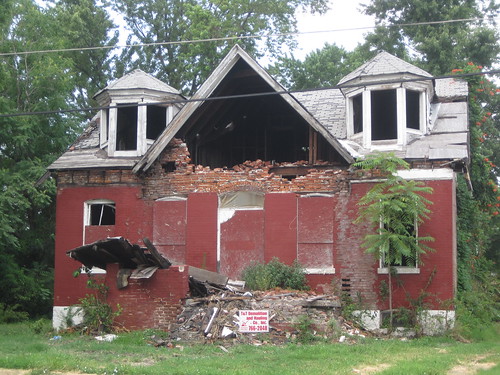by Michael R. Allen

This unusual cross-gabled house with striking dormers, located at 3839 Lee Avenue in the Fairground neighborhood, is about to be demolished. Once it is gone, an irreplaceable building — seriously, what else looks like this in the entire city? — will be lost and a predictable death pattern will conclude. Fairground and the Third Ward will lose yet another building that could house people, maintain surrounding property values and generate city revenues.
This particular house was first noted as vacant by the Building Division in 1989. The house returned to that status in 1998, and never was occupied again. The downward spiral is evident in the collapsed gable end and mess of bricks below, but also in the ownership. In 2001, after owner Albert Martin defaulted on real property taxes, the house was auctioned by the Sheriff. No one bid. The house reverted to the city’s Land Reutilization Authority (LRA), which did little except keep the plywood boards on. LRA’s lack of enterprise is somewhat understandable given the house’s condition at acceptance. On February 24, 2000, the Building Commissioner condemned the house for demolition. (Even a preservationist is baffled at how long it has taken to get this one down.)
The odd little house on Lee Avenue’s tale is not exceptional, although it should be. A negligent owner let the building fall into disrepair, stops paying taxes, lets it get condemned and then lets it lapse to city ownership. The city lacked the means to reverse long-term decay, and did no marketing of the house. By the time the wrecker put his sign in the front lawn, the story was written and only needed the detail of when demolition would start.
However, this easy and certain death could just as well have been an easy and certain rebirth. The Assessor’s Office shows that the assessed value of land and improvements at 3839 Lee Avenue were a mere $670 in 2000. Again, this is not exceptional. Many houses like this one across the city — but especially in north St. Louis — go to tax sale with low assessments and low tax liens. The economics of preservation of many of these buildings are pretty favorable to a buyer.
Where are the buyers? There are few smart people starting to use the tax auctions for preservation. For instance, artist Theaster Gates’ Rebuild Foundation has purchased at least one Hyde Park building at tax auction for rehabilitation projects. With a plentiful supply of great buildings, many of which could be eligible for historic tax credits, and few competing bidders, there seems to be a hidden buyers’ market in this city. Hidden for long, however, and we could lose quite a bit of St. Louis.

One reply on “How Easy Death, How Easy Life”
Third Ward == Third World